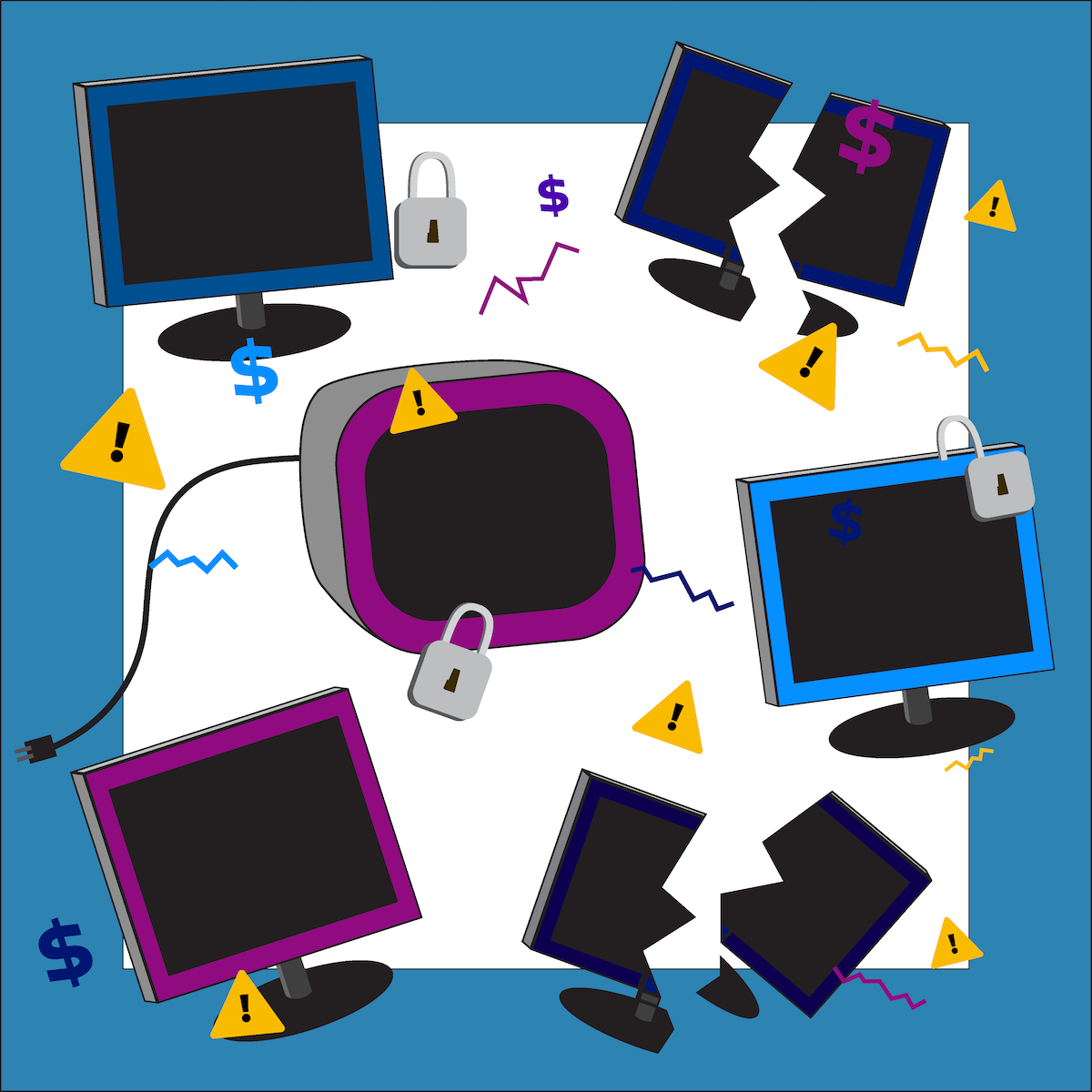With colleges mostly back to in-person classes and lifted mask mandates, a sense of normalcy is somewhat present again within the classroom environment. Attending class through a variety of options, rather than just in person, begs the question: where is the future of education headed?
Oftentimes, I fantasize about groundbreaking technology usually seen in science fiction. Whether education is led by an artificial intelligence (AI)—like the self-learning pods seen on planet Vulcan in the 2009 Star Trek film—or maybe we’ll just be able to plug into an outlet and have information dumped into us like robots a la The Matrix. For some, attending class on Zoom feels very futuristic. The future of education is quite intriguing.
While Zoom is a convenient tool for orchestrating online learning, it became the norm for quite some time. So, is remote learning here to stay? Or will it be known as something relegated to the early 2020s?
Zoom allows flexibility for those who can’t be physically present, and the platform illustrates just how far technology has come. It’s very useful for connecting communities far and wide. Learning from home might alleviate the pressure students have felt going to in-person classes—learning is just a click away from the comfort of home. But this convenience, while beneficial, also comes at a price as more specific and hands-on classes feel lackluster.
How is one supposed to learn how to weld if they can’t even come into class? How can they dissect a frog without proper direction, let alone getting a dead frog to their house? How can one play volleyball online?
Schools didn’t really have the choice at the beginning of the pandemic to keep in-person classes going, but many of us have pondered why we’ve spent so much money on tuition just to learn online.
The pros and cons vary person-to-person, but at some point, we’ve all experienced the drawbacks of online learning. Zoom fatigue is very real.
“Seeing yourself in a video chat, excessive eye contact, and reduced mobility are a few of many causes of Zoom fatigue,” wrote Vignesh Ramachandran for Stanford News of a recent peer-reviewed study.
Zoom brought new tools to the table—but not without new sets of problems. Teachers have had to navigate the world of blank screens and shoddy internet connections.
And let’s face it, I know everyone loves breakout groups, but it really doesn’t get better than being in-person.
Conversely, as we resume learning in-person, the classroom environment might not be the best thing to continue as we move forward. While a lecture format works for some, changing the classroom dynamic is something we might see in the coming years.
With the almighty, powerful and scary internet, the scope of individualized learning might become increasingly popular. Classes aren’t always set up in a way that best serves everyone’s learning needs.
Everyone learns differently—and it’s quite tricky when you put yourself in a professor’s shoes.
Some students may thrive in a lecture format—but others don’t. Author and proponent of progressive education Alfie Kohn once said that lecturing is the best way to get information from teacher’s notebook to student’s notebook without touching the students mind.
It really comes down to whether or not your professor is a good teacher—because information-dumping without any activity doesn’t help anybody.
There can be successful lectures. They just have to be more interactive and thought-provoking than anything—not just throwing information at students who absorb it like a sponge and leave without talking to anyone.
Formatting the class session in a more interactive manner could prove beneficial to those who learn differently. Going down a more hands-on and interactive route can make lectures fun and inclusive for students who are otherwise just sitting and listening for long stretches of time.
If you’re like me, you learn from doing and trying rather than just listening. However, most classes disincentivize failure and don’t have a place for it within the syllabus. In reality—whether it’s learning a new language, starting a business or coding an app—oftentimes, failure is what helps us grow and learn the most.
Many classes focus on your ability to absorb information, memorize and retain it—then test you on it. We’ve all been there: cramming and stressing for a final in a class you’re only taking because it’s required. Then, a couple of weeks later, you might’ve forgotten all about it. Seems pointless doesn’t it? Being a student, you feel merely like a moving piece in a factory.
Education needs to be more creative and involved, but it especially needs to be more comfortable.
Maybe not so comfortable that we will all be bound to a hovering chair like the humans in WALL-E, but I’d like some of the chairs’ comfort as well as more flavor and personality in the classroom setting.
For one, why are the chairs so uncomfortable and our classrooms so sterile? Nothing inspires me more than a barren and brutalist classroom at 10 a.m. Whatever happened to decoration and personality within classrooms? Do only art schools get to do that?
Quite frankly, my local coffee shop seems to have more personality than my classroom. Coffee shops invite productivity in all forms—whether it’s chatting it up with friends or working on your thesis paper. Can’t we have that atmosphere in classes?
I feel accomplished just walking through the door to see those succulent plants and trendy sitting arrangements, like I’m truly living in the future. So, why aren’t classrooms set up to look more like a creative agency than a DMV waiting room?
If the place I’m trying to learn and be productive isn’t vibrant, neither am I.
I believe that, in the future, there should be a mandate for college classes to take the first day to color and decorate the class together—like in elementary school. Stickers, glue, glitter and animals at the zoo—really anything to get those vibes up and creativity flowing.
I don’t know about you, but having a place that makes me feel welcome helps me learn. We are all creative and unique in our own way, so let’s show it in our classroom. It might be my amazing tiger drawing on the wall that gives me confidence during a speech. If classrooms continue being stale, we won’t get that. That wave of comfort you feel when you walk through that door, whether it be a coffee shop or your house, why can’t the classroom feel like that?
Sometimes doing something new and daring is what we really need for the future of education. Learning with AI could be a place to start.
For example, some schools in China use AI as a way to track students’ level of concentration throughout the class. The data is then sent to the teacher in real time, and to the parents of the students. They use a plastic headband that displays a red light when they are distracted and green for when they are focused. Using a headband with electroencephalography (EEG) technology, it monitors students’ neural activity.
The EEG technology is commonly used in hospitals and laboratories. While it is promising, it does have faults.
The technology’s accuracy is hard to gauge, as it hasn’t been widely used in other schools across the world. Certainly it’s innovative—but it’s also invasive. Who really wants to wear headgear that tells others whether or not they’re paying attention? Isn’t that shown through a student’s engagement and how they interact with the class?
Imagine the whole class being able to see if you are actually focused or not. Nothing makes a student feel more like a lab rat then having their concentration levels sent to their teacher in real time.
A student’s concentration isn’t always linear, so this becomes problematic. The technology is also susceptible to failure—if the student is fidgeting, it can affect the signal. The information can even be disrupted because of a bug bite or allergy.
We might not even be in the classroom in the future. With potential resources like the coveted metaverse, going to class will involve entering the digital world or augmented reality. By connecting students and teachers from all over the world and encouraging them to interact and share experiences, education would be more impactful and dynamic.
Imagine walking through history itself with the metaverse. To be on the front lines of the Battle of Waterloo where Napoleon takes his last stand, or in the cockpit alongside Neil Armstrong as you experience Apollo 11 and walk on the moon. Just imagine the possibilities, to travel through time—who would’ve thought?
The world of virtual reality could shake up the world of education as we know it. The metaverse has the potential for life through technology, such as the Oculus Rift. All you have to do is create an avatar and interact in a digital space like you would in real life.
So what if we attend a virtual classroom with avatars instead of one in reality? Why live a real life when you can live a virtual one? This idea is very problematic in nature. You might as well plug me in to charge.
I already feel like I’m in the metaverse when I’m on my phone for too long. Who really wants to live a fake life and have digital social interactions when you can walk outside and do the same thing—but better?
Learning in virtual reality currently seems like a gimmick. Maybe in 100 years we’ll be there—but in the present, we are not. I mean, who can really take someone seriously in a learning environment when their avatar skin is Dwayne Johnson?
The future of education is uncertain, but bound to change. We can’t keep just lecturing and treating schools like factories rather than places to learn. Education in the future could be more individualized.
Education will follow technology, but where that goes is quite unclear. We might just be plugging ourselves in to download this week’s lecture.
Regardless, the potential future of education is bright—it should be creative, interactive, accessible and fulfilling. We are all working hard toward our goals and carving out our own career path. So, after everything we’ve learned these past few years, why not make our learning space better?






